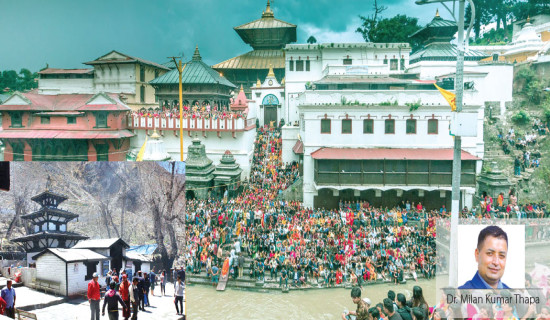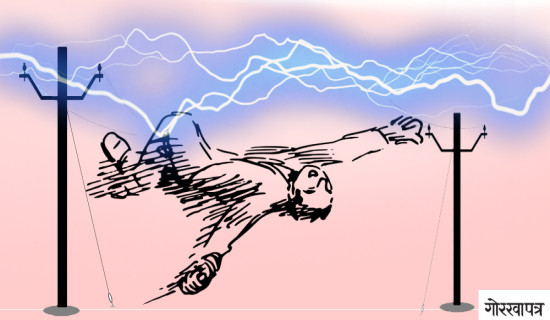- Friday, 23 May 2025
Festive Mood Of Post-Monsoon Splendour
Bishnumaya Thapa
For our parents Dashain came as an eonomic worry as they had to arrange everything ranging from a goat, new clothing, species, chiura and cash to be given as gift to the tika recipients. For the families that had no source of cash income, purchasing the festive supplies was a nightmare. In a desperate situation, a money lender had to be found and cash borrowed at heavy interest rates.
As the amounts of debts thus accumulated every year, clearing the piling up debt was herculean task. Some people sold their cattle or land while others went to work in India with the hope that the income made from the foreign job would help pay back the debt.
Most of the men who went to work in India worked there as Darwan or household security guards for merchants and businessmen. Bahadur was the title given to the men taking up such responsibility and getting a leave once a year was sometimes difficult for them. Somehow, they would manage to return home during the Maghe Sankranti festival during which borrowed money is paid back to the moneylender along with the interests. Home leave of one to two weeks was available from the master and if he failed to return to the Darwan duty on the stipulated date, the job was gone.
Clearing Loans
A man who went to do the Darwani job in India to arrange cash income for clearing the Dashain loan might have to miss the Dashain festival for several years. The family members missed him until the next Maghe Sankranti festival came. In those days, only the means of communication of the Darwan to his family members was a hand written letter that took weeks and even months to reach home. To send home a letter, an illiterate Darwan had to find somebody who could help him write one.
The letter writer needed to be well versed in the dignified etiquette and format of the letter of those days which had to pay due respect to the senior-most members of the family such as grand-parents and parents.
Equally respectful words had to be used for father-in-law and mother-in-law. The letter had to start with respectfully worded opening like, “Swasti Sri Chha Sri Age taha raj gari basnu bhaeka pujaniya mata pita ma sastanga dhog chha.” Similarly, words of blessings or aasirbad were expressed to wife, brothers, sisters and children.
Wife had to celebrate the ensuing Dashain festival without the man of the family and the children had no father with them during the celebrations. The family managed to celebrate the festival with some money sent home from India but they missed the company of the beloved man.
It is such a bitter reality associated with the Dashain festival that people used to liken it with Dasha (bad fate). When everybody is celebrating the festival you cannot skip it, and if you ignore it you will become an odd-man-out in the society. If meat is not cooking in your kitchen and if the kids are not wearing new clothes, it is a matter of humiliation, inferiority complex and being a social outcast.
For those who are well off and have source of cash income, the festival does not pose a significant problem. But for those who have no paid job, no cash crops or livestock to sell and are not engaged in some trade and business, Dashain celebration may bring financial worries and difficulties. People may be compelled to walk around in search of loans. People who spend extravagantly during the festival should think about these people who are in economically precarious condition and cannot celebrate in a happy mood.
However, no matter what is the difficulties faced by the parents, young children are in joyous and ecstatic mood when the Dashain festival approaches. It seems that this festival is especially meant for children, who do not know about all the economic concerns and worries and can enjoy the event in full merriment and mirth. When the festive mood grips the community of children, they are extra active and overjoyed, so much so that they take no time to finish works they are given. They are ready to finish their homework in advance, take share of domestic chores and do the home decorations with all energy and excitements.
This takes me back to the childhood days when we took all pains to prepare traditional paints and decorate our homes in the village in Dhading. The works we did were difficult but we found them full of joy.
We cared little about what financial worries our parents were going through. And they did not want to show us their pains so that we could celebrate the festival fully. They tried their best to hide all the worries in their face in order not to have negative impact on our child psychology.
They told us to take care of the home decoration job and that was more than enough for us. We took our bamboo baskets and went to a forest creek to collect Kamero soil to be processed and used as whitewash.
Kamero soil was usually found in an area that had water spring. In course of digging the white soil, we would get fully drenched. We had to be extremely careful as there was the danger of the soil mound collapsing.
House Painting
Anther house paint item was red soil which had to be mined and transported from a hill that was half-an-hour walk away. The place where the best red soil was found used to be crowded with diggers before the festival.
The diggers dug holes like porcupine, sometimes in a very dangerous way. Here too, collapsing of the mounds is a risky possibility which calls for extreme caution. Though no untoward incident happened in our case, there are news reports of fatal accidents in some parts of the country.
This task would otherwise have been boring and cumbersome, but it gave us energy and joy because it was associated with decorations for the Dashain festival. We worked on and on till the festival day arrived.
The next journey to the jungle had to be made to collect barks and leaves of certain plants to make black paints for the doors and windows. The work was not less labourious though we did not feel any exhaustion in the process. The bark of the Sal tree and the tender leaves of the Ureli plants were collected and carried home. They were boiled in large cauldron as the liquid dye turned from red to dark and to pitch black.
When the three paints were ready, it was finally the time for giving artistic touches for the walls, wooden pillars, doors, latticed windows and cornices. They told us the festivals come faster if we have cleaned the paths and trails leading to our homes.
Then we found ourselves engaged in joint campaign to clean the roads. The weeds and grass that grew during the rainy season were removed, flood-eroded holes filled with soil and walking steps repaired and maintained. In the post-monsoon splendour of the season, everything looked beautiful festive.
(The author writes on cultural and religious matters.)
















